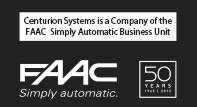Just think of that most famous of automated systems, the motor vehicle (or auto mobile in its more archaic form); the mechanised beast that safely transports us daily from one location to the next, its metallic skeleton working tirelessly and without protest to ensure that we reach our destination. But it must be remembered that – singularly wonderful as it is – a car is still a mechanical system travelling at generally high speeds, and as such there is always the inherent risk of injury or mishap.
The same applies to automated gates.
The vast majority of us will attest to the fact that the invention of gate motors – particularly ultra-fast ones like the CENTURION D10 Turbo – has made life that much more convenient. But, as with motor cars, there are certain precautions that need to be taken in order to ensure that the automatic system fulfils its purpose as safely as possible.
Infrared gate safety beams can be compared to safety belts or airbags as used in cars; providing a degree of protection to users should they find themselves in the path of a moving gate. The beams work by casting an infrared beam (as the name implies) between an electronic transmitter and receiver which, when interrupted, changes the state of an internal relay which in turn halts the operation of the connected device. When connected to a gate motor, breaking the beam will result in the gate either immediately stopping, or stopping and reversing direction depending on whether opening beams, closing beams or (most favourably) both have been connected.
Beams have been proven to be highly effective in reducing the risks associated with a moving gate such as crushing, dragging and shearing and are remarkably cost-effective and easy to install. It is therefore important that when quoting on the installation and commissioning of an automated system, infrared beams are specified as a standard. Should the user decline the fitment of additional safety equipment, the risks must be thoroughly explained and it is highly recommended that the installer gets the client to sign proof that he/she has declined them. It is also worth noting that in certain legislations it is a mandate of law to fit safety beams as a minimum safety requirement. This serves as a means for the installer of indemnifying himself in the event that injury or damage does occur subsequent to the installation.
A fully comprehensive site handover should comprise the following:
- Inspecting and testing the safety of the system
- Explaining the operation of the system to the end-user
- Demonstrating to the end-user how to test the safety of the system
- Testing and explaining the manual override facility
- Handing over all documentation (especially everything that covers safety)
There might be those users who choose to decline safety beams on the basis that they are trying to cut costs (although, as mentioned earlier, beams are extremely affordable and when incorporated into the total cost of the installation will most probably not be noticeable), and they must perhaps be reminded of the old French proverb: Bon marchétire agent de bourse – “What is cheap is most costly”.








